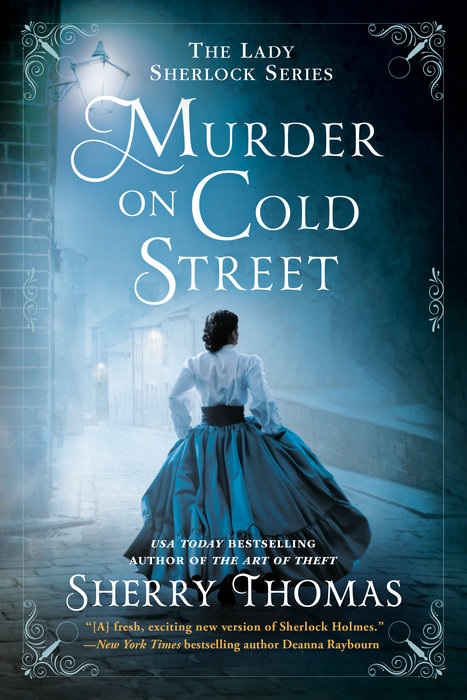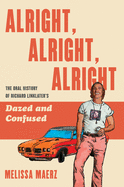 |
| photo: Jennifer Sparks |
Sherry Thomas writes historical fiction, romance and YA. Her novels have appeared on many "Best of the Year" lists. Her historical mysteries include the Lady Sherlock series (A Study in Scarlet Women, A Conspiracy in Belgravia, The Hollow of Fear, The Art of Theft), Beautiful Enemy and The Luckiest Lady in London. Her latest Lady Sherlock novel is Murder on Cold Street (Berkley). Thomas immigrated from China at age 13, and English is her second language. She lives in Austin, Tex., with her husband and sons.
On your nightstand now:
My phone, on which I've been reading a xianxia (Chinese fantasy) web novel for months.
Favorite book when you were a child:
There was this Chinese book called 365 Nights of Tales, a collection of children's stories both Chinese and international. I'm not even sure I can recall any specific stories from it, but I read that book front to back and back to front countless times. And the funny thing was, in my hometown in that era, it wasn't always easy to get stuff. So, all I ever had was the first volume of this two-volume collection. Never seen the second volume ever, anywhere.
Your top five authors:
Jin Yong (Louis Cha)
Gu Long
J.R.R. Tolkien
Judith Ivory
Laura Kinsale
Two legendary writers of wuxia (Chinese martial arts epics), one fantasy writer and two romance writers. My sensibility has always been and would probably always remain genre.
Book you've faked reading:
I'm pretty sure I never read Paradise Lost, which I was supposed to for the English IV correspondence class I took to graduate early from high school.
Book you're an evangelist for:
I have recommended the Queen's Thief series by Megan Whalen Turner a lot of times. To this day, I look at book 2 in the series and am astounded by the romance that happened.
 Book you've bought for the cover:
Book you've bought for the cover:
I have never bought a book for the cover, lol.
This is not because I am a person of substance, but because I was not given pocket money as a child. So, when I lived in China, I depended on my grandmother to buy me books--or my friends to loan me theirs. And when I came to the U.S., I relied on libraries.
Even today, that old habit persists. I will buy books to support my author friends, but for myself I only buy books I've already read wholly or partially and really, really love.
Book you hid from your parents:
Books by Gu Long (Louis Cha) which I rented to read. (That was a thing when I was growing up in China. Old men would have these little stalls in parks--or just a tarp on the ground--with books you can rent. You pay a deposit and then a daily fee to take a book home to read. I was a fast reader so typically I could get through a big martial arts epic overnight on a 30-cent daily fee.)
Book that changed your life:
A never-to-be-named historical romance that disagreed with me so violently that I decided to take up writing myself. Really changed my life. :D
Favorite line from a book:
My memory is bad so I can only recall "In a hole in the ground there lived a hobbit." I could have also put the opening line from Pride and Prejudice, but it's a little longer and I'd have to Google to make sure I'm not wrong with the wording.
Five books you'll never part with:
These are the books I brought with me from China when I came to the U.S. more than 30 years ago, so I'm confident I'll never part with them.
Happy Heroes by Gu Long, which is a take on the martial arts epic so radically different from anything else I'd read before that I fell in love instantly.
Dream of the Red Chamber, one of China's four great classic novels. My grandmother, who raised me, bought the books for me when I was in sixth grade. I used to read whole chapters aloud to myself because the language was so beautiful.
The Chinese dictionary I received from my great-aunt for my 10th birthday.
The English-Chinese dictionary that belonged to my grandmother and bears the alphabet written in her hand along the fore edge as a kind of quick index.
Stories of the Sahara by Sanmao. Actually, what I have is a mainland Chinese recompilation of her autobiographical and travel essays both from Stories of the Sahara and some other sources. The book was hugely popular in China when I was growing up, and Sanmao had such a wry, endearing, yet fierce voice.
Book you most want to read again for the first time:
Writing about the books I brought with me from China all those years ago has made me nostalgic. So, I'm going to say Stories of the Sahara by Sanmao. It was astonishing to me, as a preteen, to read about the experiences of an ethnically Chinese woman living, just living, in such faraway places. She wasn't in those faraway places to get a degree or job training or anything else that was considered "useful." She was just living there, and experiencing life deeply, sometimes in hilarity, sometimes in heartbreak.
I miss that experience, that wonder. I also miss--a little--the girl I was then, so long ago, so far away.
 In Text Me When You Get Home: The Evolution and Triumph of Modern Female Friendship (Dutton, $17), journalist Kayleen Schaefer explores the role of female friendship in contemporary life. She draws on her own experience, as well as examples of how these kinds of friendships are portrayed in the media, to shape a slim but powerful tribute to the potential of female friendship to be a defining (if not the defining) relationship in one's life.
In Text Me When You Get Home: The Evolution and Triumph of Modern Female Friendship (Dutton, $17), journalist Kayleen Schaefer explores the role of female friendship in contemporary life. She draws on her own experience, as well as examples of how these kinds of friendships are portrayed in the media, to shape a slim but powerful tribute to the potential of female friendship to be a defining (if not the defining) relationship in one's life. Intrigued by Schaefer's exploration of the many (many) ways contemporary culture highlights the more negative aspects of female friendships (catfights, backstabbing, gossip and more), I set off in search of more examples like the positive ones she shares. First to mind was Girl Squads: 20 Female Friendships that Changed History by Sam Maggs, illustrated by Jenn Woodall (Quirk, $16.99), which is exactly what it sounds like: a collection of 20 history-shaping friendships spanning from 400 BCE to present day. I am also intrigued by the scientific knowledge promised in Jacqueline Mroz's Girl Talk: What Science Can Tell Us about Female Friendship, which Shelf's reviewer said "takes the bonds between women seriously."
Intrigued by Schaefer's exploration of the many (many) ways contemporary culture highlights the more negative aspects of female friendships (catfights, backstabbing, gossip and more), I set off in search of more examples like the positive ones she shares. First to mind was Girl Squads: 20 Female Friendships that Changed History by Sam Maggs, illustrated by Jenn Woodall (Quirk, $16.99), which is exactly what it sounds like: a collection of 20 history-shaping friendships spanning from 400 BCE to present day. I am also intrigued by the scientific knowledge promised in Jacqueline Mroz's Girl Talk: What Science Can Tell Us about Female Friendship, which Shelf's reviewer said "takes the bonds between women seriously." Though Big Magic: Creative Living Beyond Fear (Riverhead, $17) is ostensibly about creativity, not friendship, it is impossible to read Elizabeth Gilbert's account of her long relationship with fellow writer Ann Patchett without reflecting on how formative that friendship has been for both women and wondering how many other lives have been shaped by friends in the same way. The same "big" theme underlies Big Friendship: How We Keep Each Other Close (Simon & Schuster, $26), in which the co-hosts of the popular Call Your Girlfriend podcast, Aminatou Sow and Ann Friedman, provide concrete recommendations for investing in long-term friendships, based on their own decade-long relationship, with all its joys and challenges. --Kerry McHugh, blogger at Entomology of a Bookworm
Though Big Magic: Creative Living Beyond Fear (Riverhead, $17) is ostensibly about creativity, not friendship, it is impossible to read Elizabeth Gilbert's account of her long relationship with fellow writer Ann Patchett without reflecting on how formative that friendship has been for both women and wondering how many other lives have been shaped by friends in the same way. The same "big" theme underlies Big Friendship: How We Keep Each Other Close (Simon & Schuster, $26), in which the co-hosts of the popular Call Your Girlfriend podcast, Aminatou Sow and Ann Friedman, provide concrete recommendations for investing in long-term friendships, based on their own decade-long relationship, with all its joys and challenges. --Kerry McHugh, blogger at Entomology of a Bookworm



 Book you've bought for the cover:
Book you've bought for the cover: John le Carré, the master of Cold War spy novels, died on Saturday at age 89. Born David Cornwell, le Carré worked in MI6, Britain's Secret Intelligence Service, and its domestic version, MI5, for 16 years. The best known of his more than two dozen books were set in MI6, "the Circus," forever at war with its Soviet counterpart, "Moscow Centre," with many of their battles played out in divided Germany. Most of the titles starred George Smiley, a taciturn, brilliant, methodical, dour, honorable, unassuming spymaster and an aficionado of German literature and language. The Spy Who Came in from the Cold, published in 1963 and le Carré's third novel, became an international bestseller, and was followed by, among others, Tinker Tailor Soldier Spy, The Honourable Schoolboy and Smiley's People.
John le Carré, the master of Cold War spy novels, died on Saturday at age 89. Born David Cornwell, le Carré worked in MI6, Britain's Secret Intelligence Service, and its domestic version, MI5, for 16 years. The best known of his more than two dozen books were set in MI6, "the Circus," forever at war with its Soviet counterpart, "Moscow Centre," with many of their battles played out in divided Germany. Most of the titles starred George Smiley, a taciturn, brilliant, methodical, dour, honorable, unassuming spymaster and an aficionado of German literature and language. The Spy Who Came in from the Cold, published in 1963 and le Carré's third novel, became an international bestseller, and was followed by, among others, Tinker Tailor Soldier Spy, The Honourable Schoolboy and Smiley's People.










